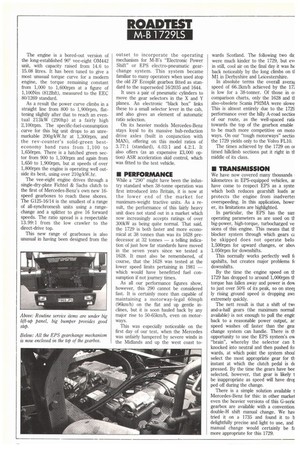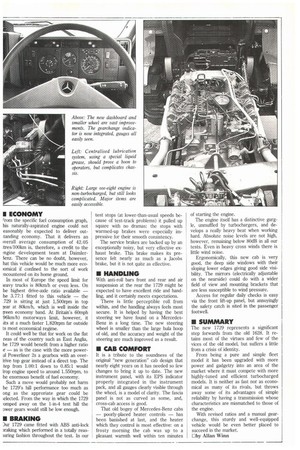ROADTEST
Page 30

Page 31

If you've noticed an error in this article please click here to report it so we can fix it.
M-B 1729LS
The engine is a bored-out version of the long-established 900 vee-eight 0M442 unit, with capacity raised from 14.6 to 15.08 litres. It has been tuned to give a most unusual torque curve for a modern engine, the torque remaining constant from 1,000 to 1,600rpm at a figure of 1,100Nm (8121bft), measured to the EEC 80/1269 standard.
As a result the power curve climbs in a straight line from 800 to 1,900rpm, flattening slightly after that to reach an eventual 213kW (290hp) at a fairly high 2,100rpm. The specific-fuel-consumption curve for this big unit drops to an unremarkable 200g/kW.hr at 1,300rpm, and the rev-counter's solid-green besteconomy band runs from 1,100 to 1,650rpm. There is a hatched green sector from 900 to 1,100rpm and again from 1,650 to 1,900rpm, but at speeds of over 1,800rpm the engine is operating well outside its best, using over 210g/kW.hr.
The vee-eight engine drives through a single-dry-plate Fichtel & Sachs clutch to the first of Mercedes-Benz's own new 16speed gearboxes to reach these shores. The G125-16/14 is the smallest of a range of all-synchromesh units using a rangechange and a splitter to give 16 forward speeds. The ratio spread is a respectable 13.99:1 from the low crawler to the direct-drive top.
This new range of gearboxes is also unusual in having been designed from the outset to incorporate the operating mechanism for M-B's "Electronic Power Shift" or EPS electro-pneumatic gearchange system. This system became familiar to many operators when used atop the old ZF Ecosplit gearbox fitted as standard to the superseded 16/2035 and 1644.
It uses a pair of pneumatic cylinders to move the gear selectors in the X and Y planes. An electronic "black box" links these to a small selector lever in the cab, and also gives an element of automatic ratio selection.
On its heavier models Mercedes-Benz stays loyal to its massive hub-reduction drive axles (built in conjunction with MAN), offering on this model ratios of 3.77:1 (standard), 4.03:1 and 4.2:1. It also offers (as an expensive 2,000 option) ASR acceleration skid control, which was fitted to the test vehicle.
• PERFORMANCE
While a "290" might have been the industry standard when 38-tonne operation was first introduced into Britain, it is now at the lower end of the market for maximum-weight tractive units. As a result, the performance of this fairly heavy unit does not stand out in a market which now increasingly accepts ratings of over 300kW as being quite normal. That said, the 1729 is both faster and more economical at 38 tonnes than was its 1628 predecessor at 32 tonnes — a telling indication of just how far standards have moved in the seven years since we tested a 1628. It must also be remembered, of course, that the 1628 was tested at the lower speed limits pertaining in 1981 — which would have benefitted fuel consumption if not journey times.
As all our performance figures show, however, this 290 cannot be considered fast. It is certainly more than capable of maintaining a motorway-legal 60mph (96km/h) on the flat and up gentle inclines, but it is soon hauled back by any major rise to 50-65km/h, even on motorways.
This was especially noticeable on the first day of our test, when the Mercedes was unfairly hampered by severe winds in the Midlands and up the west coast to wards Scotland. The following two da; were much kinder to the 1729, but evi in still, cool air on the final day it was he back noticeably by the long climbs on tl M1 in Derbyshire and Leicestershire.
In absolute terms the overall averai speed of 66.21on/h achieved by the 17`, is low for a 38-tonner. Of those in a comparison charts, only the 1628 and t1 also-obsolete Scania P92MA were slowe This is almost entirely due to the 1729 performance over the hilly A-road sectioi of our route, as the well-spaced rah( towards the top of the gearbox enable to be much more competitive on moto ways. On our "tough motorways" sectioi the 1729 yields only to the Volvo FL10.
The times achieved by the 1729 on 01 timed hillclimb sections put it right in t1 middle of its class.
• TRANSMISSION
We have now covered many thousands kilometres in EPS-equipped vehicles, as have come to respect EPS as a syste which both reduces gearshift loads at protects the engine from inadvertei overspeeding. In this application, howe' er, its limitations are highlighted.
In particular, the EPS has the san operating parameters as are used on 1.1 big-power, high-torque, turbocharged ye sions of this engine. This means that tl blocker system through which gears a be skipped does not operate belo 1,500rpm for upward changes, or alio\ 1.050rpm for downshifts.
This normally works perfectly well fi upshifts, but creates major problems fi downshifts.
By the time the engine speed on tt. 1729 has dropped to around 1,000rpm tF torque has fallen away and power is dow to just over 50% of its peak, so on steel ly rising ground speed is dropping awa extremely quickly.
The nett result is that a shift of tw( and-a-half gears (the maximum normal available) is not enough to pull the engir back to a reasonable power output, an speed washes off faster than the gea change system can handle. There is th opportunity to use the EPS system's ow "brain", whereby the selector can b knocked into neutral and then pushed fol wards, at which point the system shoul select the most appropriate gear for th instant at which the clutch pedal is d( pressed. By the time the gears have bee selected, however, that gear is likely t be inappropriate as speed will have dror pod off during the change.
There is a simple solution available t Mercedes-Benz for this: in other markei even the heavier versions of this G-serie gearbox are available with a convention double-H shift manual change. We hat tried it on a 1735 and found it to b delightfully precise and light to use, and manual change would certainly be fa more appropriate for this 1729.
I ECONOMY
■ rom the specific fuel consumption graph, his naturally-aspirated engine could not easonably be expected to deliver outtanding economy. That it delivers an )verall average consumption of 42.05 fres/100km is, therefore, a credit to the ffigine development team at Daimlerienz. There can be no doubt, however, hat this vehicle would be much more ecoiomical if confined to the sort of work :ncountered on its home ground.
In most of Europe the speed limit for Leavy trucks is 801cm/h or even less. On he highest drive-axle ratio available — he 3.77:1 fitted to this vehicle — the .729 is sitting at just 1,500rpm in top rear at 80kmfh, which is well inside the Teen economy band. At Britain's 60mph 96km/h) motorways limit, however, it its at a much faster 1,820rpm far outside Ls most economical regime.
It could well be that for work on the flat reas of the country such as East Anglia, he 1729 would benefit from a higher ratio — as is the case with the more poweral Powerliner 2s a gearbox with an over[rive top gear instead of a direct top. The tep from 1.00:1 down to 0.85:1 would kop engine speed to around 1.550rpm, to he enormous benefit of fuel economy.
Such a move would probably not harm he 1729's hill performance too much as ong as the approriate gear could be elected. From the way in which the 1729 omped away on the 1-in-4 test hill the ower gears would still be low enough.
• BRAKING
Dur 1729 came fitted with ABS anti-lock raking which performed in a totally reasAiring fashion throughout the test. In our test stops (at lower-than-usual speeds because of test-track problems) it pulled up square with no dramas: the stops with warmed-up brakes were especially impressive for their smooth consistency.
The service brakes are backed up by an exceptionally noisy, but very effective exhaust brake. This brake makes its presence felt nearly as much as a Jacobs brake, but it is not quite as effective.
• HANDLING
With anti-roll bars front and rear and air suspension at the rear the 1729 might be expected to have excellent ride and handling, and it certainly meets expectations.
There is little perceptible roll from within, and the handling always feels most secure. It is helped by having the best steering we have found on a MercedesBenz in a long time. The new steering wheel is smaller than the large hula hoop of old, and the accuracy and weight of the steering are much improved as a result.
• CAB COMFORT
It is a tribute to the soundness of the original new generation" cab design that nearly eight years on it has needed so few changes to bring it up to date. The new instrument panel, with its EPS indicator properly integrated in the instrument pack, and all gauges clearly visible through the wheel, is a model of clarity. The fascia panel is not as curved as some, and, cross-cab access is good.
That old bogey of Mercedes-Benz cabs — poorly-placed heater controls — has been banished at last, and the heater which they control is most effective: on a frosty morning the cab was up to a pleasant warmth well within ten minutes
of starting the engine.
The engine itself has a distinctive gurgle, unmuffled by turbochargers, and develops a really heavy beat when working hard. Absolute noise levels are not high, however, remaining below 80dB in all our tests. Even in heavy cross winds there is little wind noise.
Ergonomically, this new cab is very good, the deep side windows with their sloping lower edges giving good side visibility. The mirrors (electrically adjustable on the nearside) could do with a wider field of view and mounting brackets that are less susceptible to wind pressure.
Access for regular daily checks is easy via the front lift-up panel, but annoyingly the safety catch is sited in the passenger footwell.
IN SUMMARY
The new 1729 represents a significant step forwards from the old 1628. It retains most of the virtues and few of the vices of the old model, but suffers a little from a crisis of identity.
From being a pure and simple fleet model it has been upgraded with more power and gadgetry into an area of the market where it must compete with more highly-tuned and efficient turbocharged models. It is neither as fast nor as economical as many of its rivals, but throws away some of its advantages of simple reliability by having a transmission whose characteristics are mismatched to those of the engine.
With revised ratios and a manual gearchange, this sturdy and well-equipped vehicle would be even better placed to succeed in the market.
Oby Allan Winn




















































































